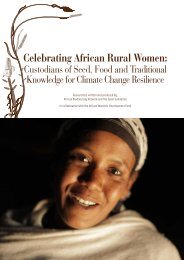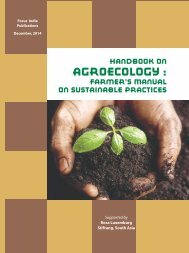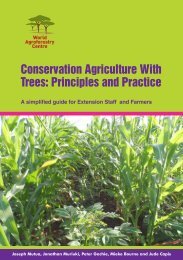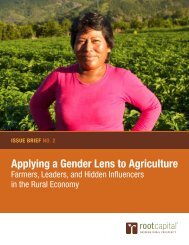1t0SC7l
1t0SC7l
1t0SC7l
Create successful ePaper yourself
Turn your PDF publications into a flip-book with our unique Google optimized e-Paper software.
Table 5.1. Indigenous and exogenous solutions to identified production constraints<br />
Species Constraints Farmers’ solution Technicians’ solution Action<br />
1. Cassava *Root rot<br />
*Curly leaves<br />
*Early harvest, crop<br />
rotation, planting of<br />
many varieties<br />
*none<br />
*Resistant varieties<br />
*Resistant varieties<br />
*On station<br />
research<br />
*On station<br />
2. Groundnut *Stunted plant<br />
and curly leaves<br />
*Empty pods<br />
3. Cocoa *Drying and<br />
sudden tree death<br />
(‘die-back’)<br />
*Pods brawn rot<br />
(Phytophtora<br />
megacaria)<br />
4. Cocoyam *Tuber rot<br />
*Yellowing of<br />
5. Bananaplantain<br />
6.Cucumber<br />
(Cucumeropsis<br />
mannii)<br />
leaves<br />
*Rhizome and<br />
root rot<br />
*Yellowing of<br />
leaves<br />
*Low yield, fruit<br />
rot, predation<br />
7. Maize *Stem borer<br />
attacks<br />
*Weevil attacks<br />
on stored grains<br />
*none<br />
* none<br />
*Pruning or<br />
replacement of dead<br />
tree<br />
*Use of fungicides<br />
*none<br />
*none<br />
*Use of ash and<br />
methyl on planting<br />
bulb<br />
*none<br />
*none<br />
*Use of ash and<br />
methyl insecticide<br />
* Methyl parathion<br />
*Disease-free cuttings<br />
*Early and dense planting<br />
*Early varieties, calcium<br />
and phosphorus fertiliser<br />
*None<br />
*Sanitary harvest and<br />
treatment<br />
*Resistant varieties<br />
*Resistant varieties<br />
*Nematicide and<br />
insecticide treatment of<br />
stock bulb before planting<br />
*Tolerant varieties<br />
*Mastery of farmers<br />
cultural practices<br />
*Biological control<br />
*Insecticide treatment<br />
research<br />
*Extension<br />
message<br />
*On farm<br />
research<br />
*In depth<br />
diagnosis by<br />
research<br />
*Extension<br />
message<br />
*On station<br />
research<br />
*Extension<br />
message<br />
*On station<br />
research<br />
*In depth<br />
diagnostic<br />
survey<br />
*On station<br />
research<br />
*Extension<br />
8. Yam *Tuber rot *none *Tolerant varieties *On station<br />
research<br />
9. Soil *Short length<br />
natural fallow and<br />
decrease fertility<br />
*none<br />
*Improved fallow and<br />
agroforestry, combined<br />
application of mineral and<br />
*On station and<br />
on farm<br />
research<br />
10. Crop<br />
produce<br />
*Poor sale and<br />
deterioration<br />
11. Land *Too little farm<br />
land available<br />
12. Investment *Absence of<br />
capital<br />
13. Seeds *Poor quality;<br />
absence of seed<br />
policy<br />
*none<br />
*Shortening of fallow<br />
length<br />
*’Tontine’ groups<br />
*Seeds from preceding<br />
harvest, neighbours or<br />
market<br />
organic fertilisers<br />
*Improved processing and<br />
conservation techniques,<br />
creation of farmers<br />
organisation<br />
*Revision of land tenure<br />
law<br />
*Community groups,<br />
Government credit<br />
scheme<br />
*Agricultural seed<br />
producers, seed legislation<br />
and policy<br />
*On farm<br />
research,<br />
extension<br />
support service<br />
*Government<br />
*Extension<br />
*Extension<br />
message,<br />
Government<br />
Soil conservation: studies have to be carried out on possibilities to intensify crop production<br />
within this rotational system. This intensification can be achieved by prolonging the cropping<br />
period without complete degradation of soil fertility or by shortening the fallow period applying<br />
improved fallow technologies. To extend the cropping phase, a solution can be found in the<br />
51








